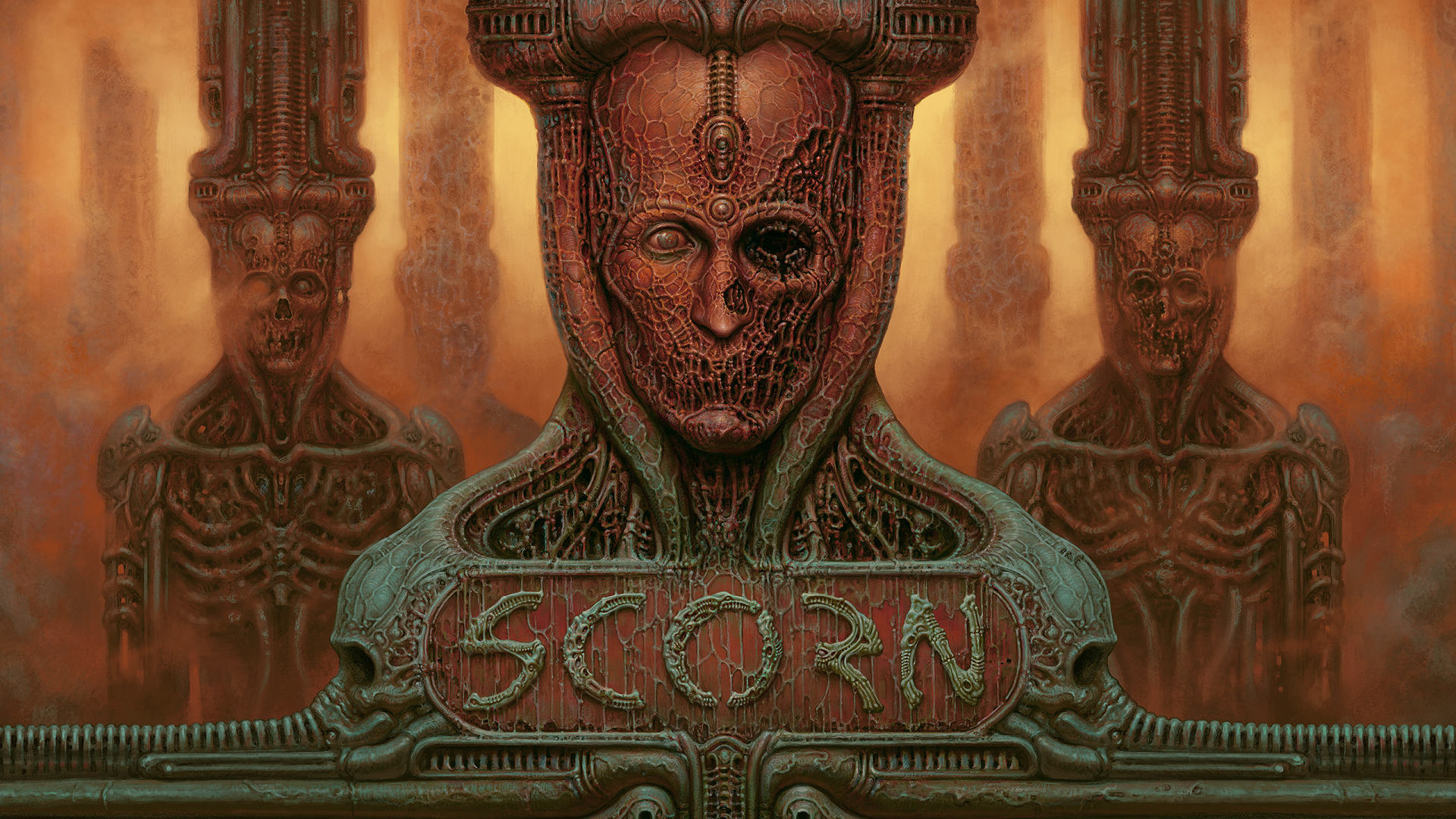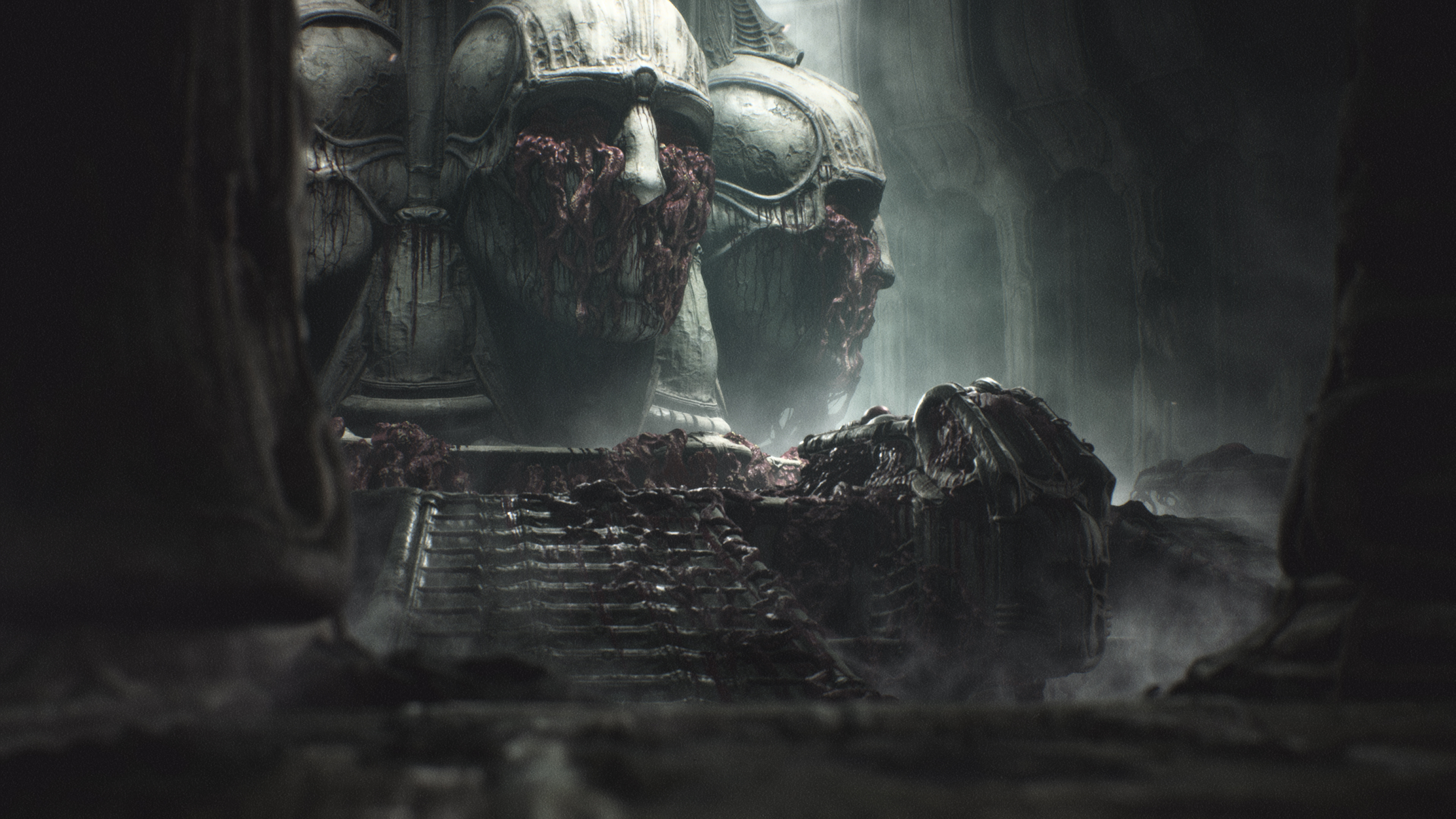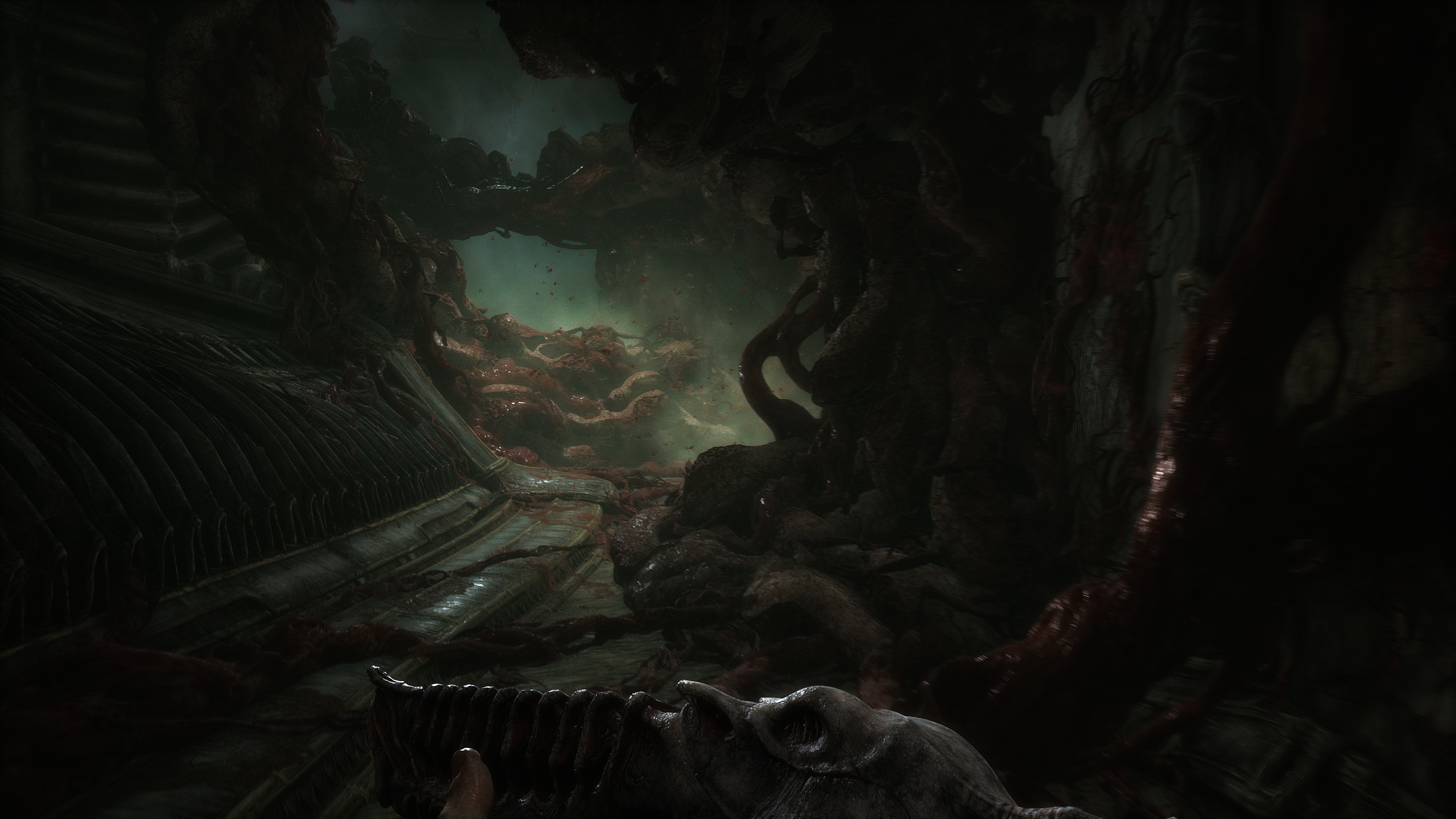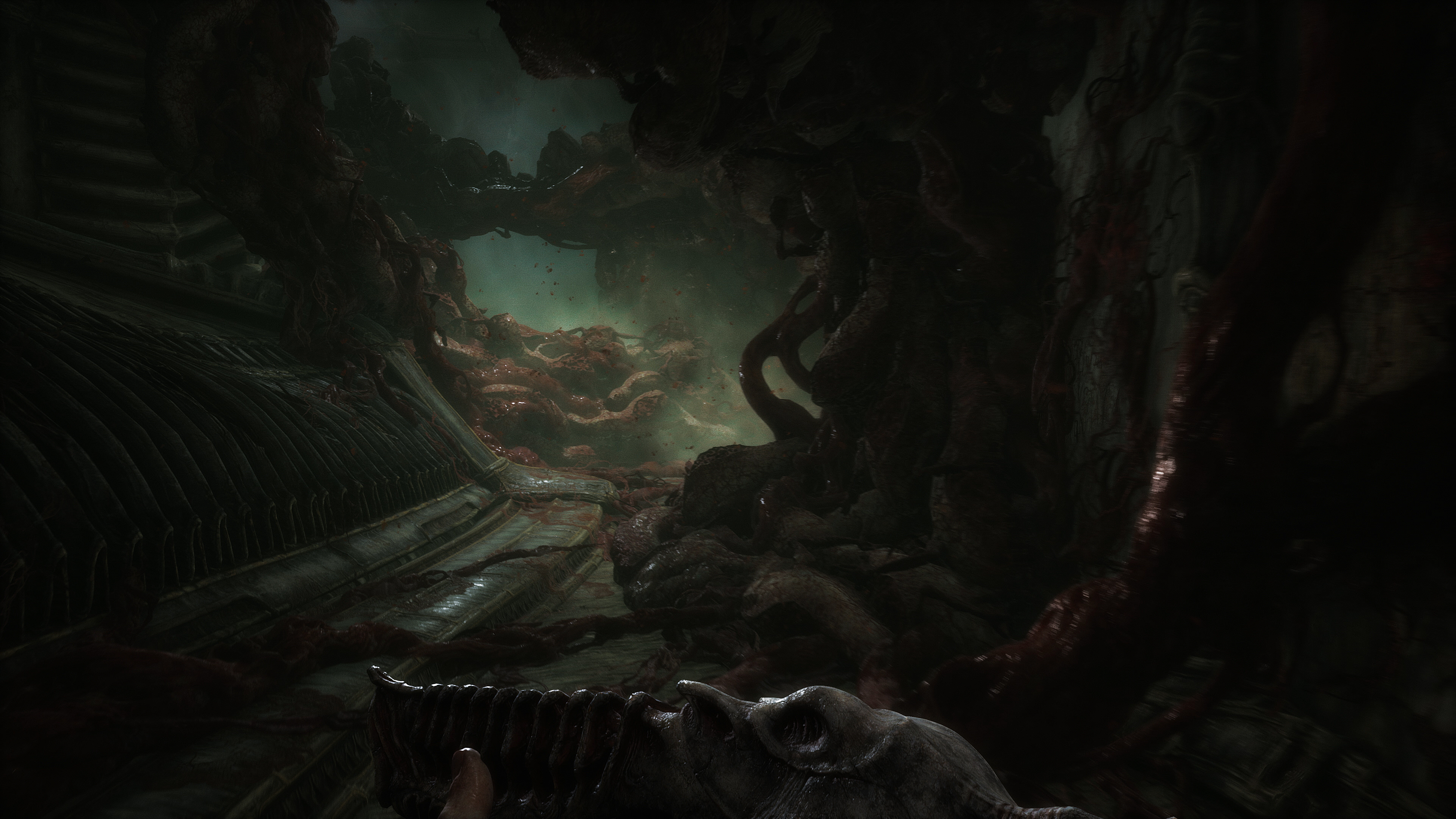You come in reeling from the main menu, having just opted to start a new game, and watch the title art unfold as you tear yourself from the writhing mess in which you find yourself embroiled. Haunted by visions, the passing of time, or perhaps both, you awake somewhere, and it is your lot to now march stoically unto progress or death. Before long, you find yourself pulling out an umbilical cord, and this game’s intent is immediately clear – you’re to receive no help here.
And this stark message tells you all you need to know going into Scorn; you will get no commands or directives, the systems and controls will not be explained, and there will be no conveniently exposition-heavy conversations either now nor towards the game’s climax. Nothing is even named. There is, in fact, not a single word present outside of the game’s menus, written or spoken.
My advice? Memorize the control scheme in the pause menu from the off, and try each command whenever the next esoteric grotesquerie finds its way into your possession. Don’t be like me and realize you have an approximation of an inventory screen as you’re nearing the end. Though this, of course, is told in the game’s own language of viscera and must first be deciphered.
There is a minimal HUD here, too – it surfaces when absolutely vital to do so, displaying a few key details, such as your remaining health, before scurrying away to leave your eyeline of Scorn’s world unbroken. It’s all the better for it, too, as you’ll be dying to see every last inch of this immaculately detailed living gallery that Ebb has created.
The Giger counter on Google Trends must be absolutely off the charts right now – Scorn’s promo art is even served as a top result for a search of the Swiss artist, evocatively name-dropped in press release and review alike, alongside Zdzisław Beksiński’s otherworldly visions. And it is absolutely a marriage of these artistic approaches – perhaps owing a little to earlier surrealists such as Alfred Kubin, too – and has been realized and executed par excellence.
The level of detail on display is astonishing, to be perfectly honest – there’s not a wasted pixel across Scorn’s handful of biomes, spanning a multitude of dank, labyrinthine buildings peppered with the occasional bit of out-of-doors. Each component part of the decaying, biomechanical world is highly stylized and often recognizably of-Earth despite its distinct capital-A Alien flavor. A window’s shutters can look like the chitin of a beetle’s shell, spines appear to hold up the ceiling in places, and there’s a glut of more, shall we say, explicit references, as well.
Sex, birth, life, and death loom large here, and these themes feed into the design ethos of both environment and equipment. Weapons thrust and pulse, and you’ll insert your limbs and digits into a huge number of fleshy holes that serve as switches or input devices for machinery before the credits roll. Despite the narrative silence, a subtle game this is not. But for all of its experimental leanings and bucking of established forms and conventions in the medium, Scorn is still very much a game, and ultimately, unfortunately, to its detriment.
While Scorn is billed as a horror title, it’s far more a ponderous and mood-led piece than most other examples of the genre. There is palpable tension and atmosphere in spades, but Scorn is not a scary experience as such. You may well squirm from the numerous gratuitous displays of gore or body horror, but there are no definitive nope moments, such as the likes of Mr. X’s first appearance in Resident Evil 2 or most of Outlast. And I feel that a good part of this is due to the lack of any real threat for most of the game.
Which is to say, while the handful of enemy types are pretty lethal, with even the smallest of foes capable of wrecking you quite quickly if you let them, they are also pretty darn stupid. They’re damage sponges, too, but all it takes to dispatch them is positioning and a little cover, of which there is plenty everywhere.
Ultimately, there’s very little recourse for them. Even the toughest fights of the game are rendered fairly inert by kiting around a pillar. And if there isn’t a pillar, simply turn and run the other way; odds are, when you return to the room, they’ll have left. You could also just press straight past them, as most won’t pursue you for any real distance.
The combat itself is a fairly bog-standard, first-person survival horror affair, and nothing to write home about – all scarce ammo supplies and slow movement. Paired with the AI’s shortfalls, however, it quickly becomes a thrill-less chore. Mercifully, there isn’t that much of it to be done, and less still that is obligatory.
The other major grievance here is the signposting around some of the game’s puzzles. Across my six-hour playthrough, a quarter of that was trying to navigate the prologue’s first puzzle, which, it turned out, had not rendered the indicator on the solution and instead left me staring at a series of identical options with nothing but trial and error between me and actually getting into the game proper.
While I believe this has been addressed in a day-one patch, and it didn’t affect everyone in the pre-release build to begin with, the opening section is still punishingly obtuse. This could be a real sticking point for players, particularly as Scorn is on Games Pass, and a good chunk of the player base will not feel obliged to continue if it infuriates rather than pleases that early on.
Act I is far and away the worst offender for this, though. It’d be a real shame for people to miss out on Scorn’s union of aesthetics, environmental narrative, and the solutions to the problems that arise as you trudge ever towards your uncertain destination, which it does succeed in evoking most of the time.
Scorn Review — The Bottom Line
Pros
- Possibly one of the greatest realizations of an artistic vision seen in a video game.
- Remarkable world design.
Cons
- Janky, unsatisfying combat.
- Some puzzles are torturously ill-signposted.
- The plot is perhaps a little too vague.
Scorn occupies a strange, fringe space in a wider survey of video games, sitting halfway between something of a survival horror game and — not in pejorative terms — a walking simulator. Instead of being repulsive, the distorted and blood-strewn world draws players in. Rather than trying to get from A to B ASAFP, as you may in a more traditional horror game, you’ll find yourself losing a lot of time just poking around the labyrinth and drinking it in.
It’s lamentable that the game itself around this fantastical world serves to mar your presence in it somewhat. Some tweaks to how the puzzles are laid out, and admittedly some much more considered efforts around the combat – which, in its current state, is fairly non-threatening and easily cheesable – could elevate Scorn to the horror pantheon across mediums.
It’s still an easy recommendation if just for the art, which I’m sure it will be remembered for. But the full picture is one of a frustratingly imperfect piece of art; Look on my Works, ye Mighty, and despair for what it could have been.
[Note: Ebb software provided the copy of Scorn used for this review.]











Published: Oct 14, 2022 02:18 pm